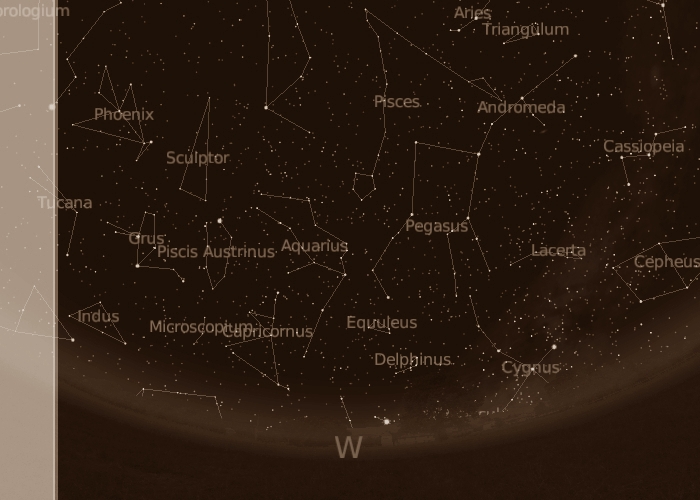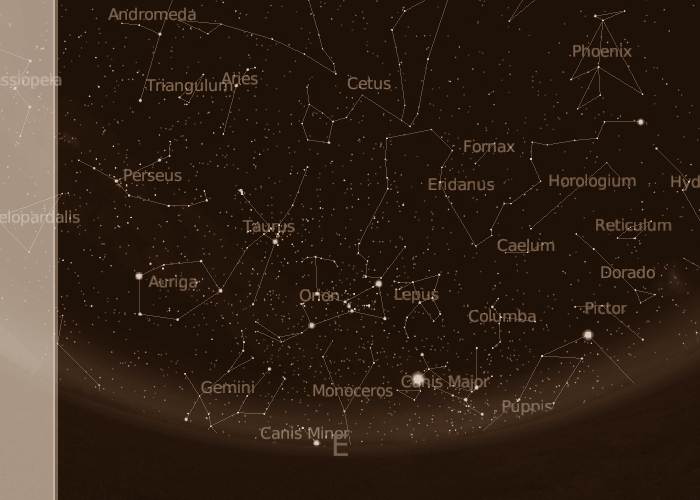Western Horizon
Eastern Horizon
Precisions About Daylight Saving Time (DST) Adjustments
![]()
Western Horizon
Eastern Horizon
Precisions About Daylight Saving Time (DST) Adjustments

The sky, in fall, at the tropics is an ensemble of sky patches of interest. West, the Summer Triangle, this distinctive feature of the summer skies in the northern hemisphere, has now almost reached the horizon. About only Deneb, of Cygnus, the Swan is seen, low. Above, the Great Square of Pegasus and the other parts of Pegasus, the Winged Horse, are seen, high. A fine show! Higher still, northeast, don't miss M31, the famed Andromeda Galaxy. The Andromeda Galaxy, on the chart, is the grey oval. M31 is a fine binocular object, as this large, spiral galaxy is a view of our own Milky Way Galaxy, could we see it from the outside. As Capricornus, the Goat, is tending low, slightly southwest, Aquarius, the Water Bearer is well seen, high. The bright star in the region is Fomalhaut, of Piscus Austrinis, the Southern Fish. All the constellations southwest are allowing us to transition to the southern horizon, with Grus, the Crane, Sculptor, the Sculptor joining to Phoenix, the Phoenix, or Horologium, the Clock, to form a flurry of small, typically southern constellations. Such bright stars like Alnair of Grus, or Achernar are seen. Fine views! As, further both the Small and the Large Magellanic Clouds are seen! The bright star, southeast, is Canopus. to a printer-friendly chart
West for the mid-northern latitudes. West for the mid-southern latitudes

East, you will see how Orion, the Hunter, this fine constellation, has now risen from the horizon. Orion, the Hunter, this large quadrilateral of stars, easy to spot with the three stars of the Orion's Belt aligned in its center. Orion, in the northern hemisphere is the center of a large group of fine constellations, which constitutes there the distinctive feature of the winter nights! The bright star, low, at the lower right of Orion are Sirius -the sky's brightest star- and stars of Canis Major, the Great Dog. Another remarkable show is to the upper left of the quadrilateral of Orion, with the bright Capella, of Auriga, the Charioteer, and Aldebaran -and the V-shaped Hyades- of Taurus, the Bull. Another fine view, at last, is seen, as Eridanus, the River Eridanus is taking its source at Rigel, and meandering a long way to Achernar. Perseus, Perseus, is high northeast, as the tiny Pleiades are to the upper left of Aldebaran. Should you have the northern horizon available, just turn there! A fine ensemble is provided there, with the Milky Way running from Deneb to Capella, through Cassiopeia, the Queen, and Perseus, as the upper part of the sky is filled with Pegasus, Andromeda, down to Taurus. Fine views! to a printer-friendly chart
East for the mid-northern latitudes. East for the mid-southern latitudes
->Contrarily to what is seen in the northern hemisphere, or the southern, equatorial and tropical countries do not have any Daylight Saving Time (DST), as at these latitudes days are equaling nights all year long
Website Manager: G. Guichard, site 'Amateur Astronomy,' http://stars5.6te.net. Page Editor: G. Guichard. last edited: 12/28/2010. contact us at ggwebsites@outlook.com